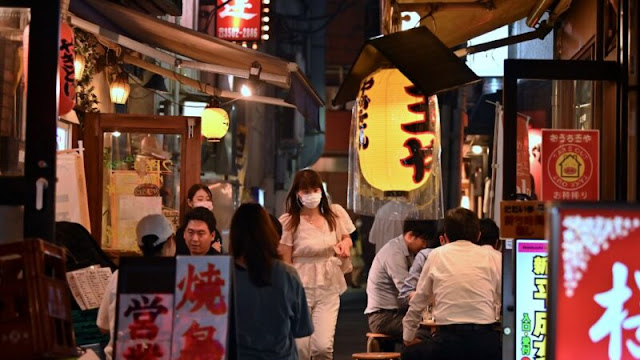Editor : Lu Yongxin
Publisher : New Tang Dynasty Television
Translation, editing : Gan Yung Chyan
/ KUCINTA SETIA
Image : The Tokyo Metropolitan Government lifted the "Tokyo Alert" on 11 June and further relaxed the closing time for izakaya and other restaurants on 12 June. The picture shows people dining in the alleys of the Shimbashi district of Tokyo on 17 June. ( Charly Triballeau / AFP via Getty Images)
As of 17 June 2020, the total number of confirmed cases of covid is 17,689. Among the 47 prefectures of Japan, Tokyo with a total of 5674 cases on 17 June is the most serious, and only Iwate prefecture maintains "zero case" in the territory, which is called "the miracle of Iwate prefecture".
The Tokyo Metropolitan Government lifted the "Tokyo Alert" on 11 June and further relaxed the closing time for izakaya and other restaurants on 12 June. It is currently expected that, with the exception of some large-scale activities, the "call to suspend business" will be lifted from 19 June, and economic activities will return to normal.
Since the lifting of the state of emergency, there have been more than 20 new cases in a single day in Tokyo. Today, 41 new cases have been confirmed in a single day, which is another 40 cases after 15 days. A total of 5674 cases have been reported so far. Hence, the Tokyo Metropolitan Government continue to appeal people to prevent and control the epidemic.
Iwate Prefecture maintains "zero diagnosis" Officials: fewer Chinese tourists
According to statistics released by the Japan Broadcasting Association (NHK), 46 of the 47 prefectures in Japan have fallen successively, and Iwate Prefecture, with a population of only 1.23 million people, still maintains a "zero diagnosis" to this day. All walks of life are concerned and sparked discussions.
Since Morioka Station, located in the northeastern local transportation hub, is located in Morioka City, Iwate Prefecture, "(geographical factors alone) cannot be explained (zero cases)." US media The Wall Street Journal even reported in mid-May that Iwate Prefecture had been hit by the 2011 311 earthquake and about 5800 people were killed. Why was it possible to survive the epidemic, one of the reasons is "Natural barrier" because Iwate prefecture is surrounded by the northern highlands and the Ou Mountains.
The report also interviewed the official responsible for the epidemic prevention work in Iwate Prefecture. "Since the 311 earthquake, the county residents have a sense of crisis"; the report also introduced relevant personnel on the Shinkansen platform to measure the temperature of passengers and other anti-epidemic measures .
Japanese media also visited officials in Iwate Prefecture in April. "Why can there be zero cases" and "whether there are any special anti-epidemic measures", etc., said that the return ticket to and from the Shinkansen in Tokyo will cost more than 30,000 yen (about US$281), which is not casual If you want to play, you will come to play, and it is also related to the seriousness of the county residents to wash their hands.
Another possible reason is that compared with places like Hokkaido and Miyagi Prefecture, there are fewer Chinese tourists in Iwate Prefecture, and they may be spared when the epidemic in January and February is delayed.
The Japan Broadcasting Association (NHK) reported that as of 17 June, there were 17,689 confirmed cases in Japan, plus 712 cases of the Diamond Princess, a total of 18,401 cases. There are 948 deaths, including 935 cases in Japan and 13 cases of Diamond Princess.



No comments:
Post a Comment